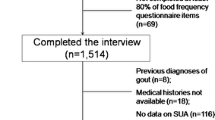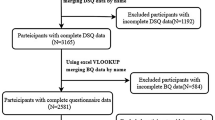Abstract
We aimed to explore correlations between lifestyle choices and hyperuricemia in a large Chinese population, emphasizing the differences from opposite sex. Ten thousand four hundred fifty subjects were randomly recruited from Tianjin municipality in China. Hyperuricemia was defined as serum uric acid >420 μmol/L for men and >360 μmol/L for women. Demographic data, highest education degree, work type, commuting means, smoking and drinking status, exercise frequency, and quantitative assessments of dietary factors were collected. Anthropometric measurements and fasting blood tests were performed. Statistical analyses were conducted. Total hyperuricemic prevalence was 12.89 %, with male significantly higher than female. Body mass index, waist circumference, serum indices, and age displayed high correlation coefficients, and most lifestyle factors also showed significant correlations as well. Binary logistic regression models showed odds ratio of developing hyperuricemia were much greater in males than in females by eating habits. However, physical activity-related lifestyle choices tended to cast much greater influences on the likelihood of hyperuricemia in females. Lifestyle choices and hyperuricemia are closely related. For males, eating habits have greater influences on the likelihood of developing hyperuricemia. For females, lifestyle factors like work type, commuting method, and exercise have such effects.
Similar content being viewed by others
References
Zhang Q, Lou S, Meng Z et al (2011) Gender and age impacts on the correlations between hyperuricemia and metabolic syndrome in Chinese. Clin Rheumatol 30:777–787
Miao Z, Li C, Chen Y et al (2008) Dietary and lifestyle changes associated with high prevalence of hyperuricemia and gout in the Shandong coastal cities of Eastern China. J Rheumatol 35:1859–1864
Choi HK, Ford ES (2007) Prevalence of the metabolic syndrome in individuals with hyperuricemia. Am J Med 120:442–447
Choi HK, Atkinson K, Karlson EW et al (2004) Alcohol intake and risk of incident gout in men: a prospective study. Lancet 363:1277–1281
Yu KH, See LC, Huang YC et al (2008) Dietary factors associated with hyperuricemia in adults. Semin Arthritis Rheum 37:243–250
Choi HK, Curhan G (2004) Beer, liquor, and wine consumption and serum uric acid level: The Third National Health and Nutrition Examination Survey. Arthritis Rheum 51:1023–1029
Choi HK, Atkinson K, Karlson EW et al (2004) Purine-rich foods, dairy and protein intake, and the risk of gout in men. N Engl J Med 350:1093–1103
Villegas R, Xiang YB, Elasy T et al (2012) Purine-rich foods, protein intake, and the prevalence of hyperuricemia: The Shanghai Men’s Health Study. Nutr Metab Cardiovasc Dis 22:409–416
Choi HK, Liu S, Curhan G (2005) Intake of purine-rich foods, protein, and dairy products and relationship to serum levels of uric acid: The Third National Health and Nutrition Examination Survey. Arthritis Rheum 52:283–289
Gao X, Curhan G, Forman JP et al (2008) Vitamin C intake and serum uric acid concentration in men. J Rheumatol 35:1853–1858
Lyu LC, Hsu CY, Yeh CY et al (2003) A case–control study of the association of diet and obesity with gout in Taiwan. Am J Clin Nutr 78:690–701
Choe JY, Park SH, Kim JY et al (2008) Change in serum uric acid between baseline and 1-year follow-up and its associated factors in male subjects. Clin Rheumatol 27:483–489
Choi HK, Curhan G (2005) Gout: epidemiology and lifestyle choices. Curr Opin Rheumatol 17:341–345
Shu XO, Yang G, Jin F et al (2004) Validity and reproducibility of the food frequency questionnaire used in the Shanghai Women’s Health Study. Eur J Clin Nutr 58:17–23
Villegas R, Yang G, Liu D et al (2007) Validity and reproducibility of the food-frequency questionnaire used in the Shanghai men’s health study. Br J Nutr 97:993–1000
Garrel DR, Verdy M, PetitClerc C et al (1991) Milk– and soy–protein ingestion: acute effect on serum uric acid concentration. Am J Clin Nutr 53:665–669
Brule D, Sarwar G, Savoie L (1992) Changes in serum and urinary uric acid levels in normal human subjects fed purine-rich foods containing different amounts of adenine and hypoxanthine. J Am Coll Nutr 11:353–358
Yamakita J, Yamamoto T, Moriwaki Y et al (1998) Effect of Tofu (bean curd) ingestion and on uric acid metabolism in healthy and gouty subjects. Adv Exp Med Biol 431:839–842
Breslau NA, Brinkley L, Hill KD et al (1988) Relationship of animal protein-rich diet to kidney stone formation and calcium metabolism. J Clin Endocrinol Metab 66:140–146
Azadbakht L, Kimiagar M, Mehrabi Y et al (2007) Soy inclusion in the diet improves features of the metabolic syndrome: a randomized crossover study in postmenopausal women. Am J Clin Nutr 85:735–741
Hak AE, Choi HK (2008) Menopause, postmenopausal hormone use and serum uric acid levels in US women—The Third National Health and Nutrition Examination Survey. Arthritis Res Ther 10:R116
Yahyaoui R, Esteva I, Haro-Mora JJ et al (2008) Effect of long-term administration of cross-sex hormone therapy on serum and urinary uric acid in transsexual persons. J Clin Endocrinol Metab 93:2230–2233
Sumino H, Ichikawa S, Kanda T et al (1999) Reduction of serum uric acid by hormone replacement therapy in postmenopausal women with hyperuricaemia. Lancet 354:650
Shi M, Wang X, Yamanaka T et al (2007) Effects of anaerobic exercise and aerobic exercise on biomarkers of oxidative stress. Environ Health Prev Med 12:202–208
Lippi G, Brocco G, Franchini M et al (2004) Comparison of serum creatinine, uric acid, albumin and glucose in male professional endurance athletes compared with healthy controls. Clin Chem Lab Med 42:644–647
Huang LL, Huang CT, Chen ML et al (2010) Effects of profuse sweating induced by exercise on urinary uric acid excretion in a hot environment. Chin J Physiol 53:254–261
Green HJ, Fraser IG (1988) Differential effects of exercise intensity on serum uric acid concentration. Med Sci Sports Exerc 20:55–59
Francis K, Hamrick ME (1984) Exercise and uric acid: implication in cardiovascular disease. J Orthop Sports Phys Ther 6:34–39
Paffenbarger RS Jr, Hyde RT, Wing AL et al (1993) The association of changes in physical-activity level and other lifestyle characteristics with mortality among men. N Engl J Med 328:538–545
Krzystek-Korpacka M, Patryn E, Kustrzeba-Wojcicka I et al (2011) The effect of a one-year weight reduction program on serum uric acid in overweight/obese children and adolescents. Clin Chem Lab Med 49:915–921
Janssen GM, Degenaar CP, Menheere PP et al (1989) Plasma urea, creatinine, uric acid, albumin, and total protein concentrations before and after 15-, 25-, and 42-km contests. Int J Sports Med 10(Suppl 3):S132–S138
Acknowledgments
This investigation was supported by Tianjin Science and Technology Committee Foundation grants 11ZCGYSY05700 and 10JCZDJC19000, China National Natural Science Foundation grant 30900376, Tianjin Medical University Scientific Research grant 2008KY20, and Tianjin Medical University New Century Excellent Talent Program (awarded to Zhaowei Meng).
Young and Middle-aged Innovative Talent Training Program from Tianjin Education Committee (awarded to Zhaowei Meng).
Disclosure
None.
Author information
Authors and Affiliations
Corresponding author
Additional information
Li Liu and Shanshan Lou as co-first authors contributed equally in this paper.
Rights and permissions
About this article
Cite this article
Liu, L., Lou, S., Xu, K. et al. Relationship between lifestyle choices and hyperuricemia in Chinese men and women. Clin Rheumatol 32, 233–239 (2013). https://doi.org/10.1007/s10067-012-2108-z
Received:
Revised:
Accepted:
Published:
Issue Date:
DOI: https://doi.org/10.1007/s10067-012-2108-z




